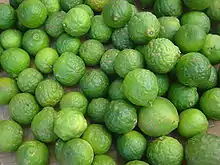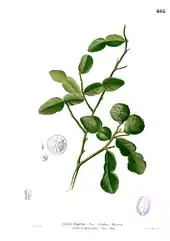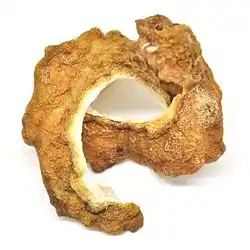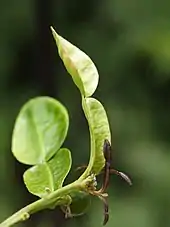Kaffir lime
Citrus hystrix, called the kaffir lime, makrut lime[3] (US: /ˈmækrət/, UK: /məkˈruːt/), Thai lime or Mauritius papeda,[4] is a citrus fruit native to tropical Southeast Asia and southern China.[5][6]
| Kaffir lime | |
|---|---|
 | |
| Scientific classification | |
| Kingdom: | Plantae |
| Clade: | Tracheophytes |
| Clade: | Angiosperms |
| Clade: | Eudicots |
| Clade: | Rosids |
| Order: | Sapindales |
| Family: | Rutaceae |
| Genus: | Citrus |
| Species: | C. hystrix |
| Binomial name | |
| Citrus hystrix | |
| Synonyms[2] | |
| |
Its fruit and leaves are used in Southeast Asian cuisine and its essential oil is used in perfumery.[7] Its rind and crushed leaves emit an intense citrus fragrance.
Names
The etymology of the name "kaffir lime" is uncertain.
C. hystrix is known by various names in its native areas:
- jeruk purut in Indonesia.
- jiàn yè chéng (箭叶橙) in Chinese.
- kabuyaw or kulubot in the Philippines,[8] where the city of Cabuyao in the Laguna province is named after the fruit.
- limau purut in Malaysia. The name refers to the bumpy texture of the fruit.[9]
- makrud or makrut (มะกรูด, /máʔ.krùːt/) in Thailand (a name also used for the bergamot orange).
- mak khi hut (ໝາກຂີ້ຫູດ, /ma᷆ːk.kʰi᷆ː.hu᷆ːt/) in Laos.
- trúc or chanh sác in Vietnam.[5][10]
- combava in Réunion Island
- gondhoraj lebu in West Bengal, India and Bangladesh
The micrantha, a similar citrus fruit native to the Philippines that is ancestral to several hybrid limes, such as the Key lime and Persian lime, may represent the same species as C. hystrix, but genomic characterization of the kaffir lime has not been performed in sufficient detail to allow a definitive conclusion.[11]
Description


C. hystrix is a thorny bush, 2 to 11 metres (6 to 35 ft) tall, with aromatic and distinctively shaped "double" leaves.[16][17] These hourglass-shaped leaves comprise the leaf blade plus a flattened, leaf-like stalk (or petiole). The fruit is rough and green, and ripens to yellow; it is distinguished by its bumpy exterior and its small size, approximately 4 cm (2 in) wide.[17]
Uses


Cuisine
The leaves are the most frequently used part of the plant, fresh, dried, or frozen. The leaves are widely used in Thai[18][19] (for dishes such as tom yum) and Cambodian cuisine (for the base paste "krueng").[20] The leaves are used in Vietnamese cuisine to add fragrance to chicken dishes and to decrease the pungent odor when steaming snails. The leaves are used in Indonesian cuisine (especially Balinese cuisine and Javanese cuisine) for foods such as soto ayam and are used along with Indonesian bay leaf for chicken and fish. They are also found in Malaysian and Burmese cuisines.[21] It is used widely in Bengali and South Indian cuisine.
The rind (peel) is commonly used in Lao and Thai curry paste, adding an aromatic, astringent flavor.[18] The zest of the fruit, referred to as combava, is used in creole cuisine to impart flavor in infused rums and rougails in Mauritius, Réunion, and Madagascar.[22] In Cambodia, the entire fruit is crystallized/candied for eating.[23]
Medicinal
The juice and rinds of the peel are used in traditional medicine in some Asian countries; the fruit's juice is often used in shampoo and is believed to kill head lice.[17]
Other uses
The juice finds use as a cleanser for clothing and hair in Thailand[19] and very occasionally in Cambodia. Lustral water mixed with slices of the fruit is used in religious ceremonies in Cambodia.
Cultivation
C. hystrix is grown worldwide in suitable climates as a garden shrub for home fruit production. It is well suited to container gardens and for large garden pots on patios, terraces, and in conservatories.
Main constituents
The compound responsible for the characteristic aroma was identified as (–)-(S)-citronellal, which is contained in the leaf oil up to 80 percent; minor components include citronellol (10 percent), nerol and limonene.
From a stereochemical point of view, it is remarkable that kaffir lime leaves contain only the (S) stereoisomer of citronellal, whereas its enantiomer, (+)-(R)-citronellal, is found in both lemon balm and (to a lesser degree) lemon grass, (however, citronellal is only a trace component in the latter's essential oil).
Kaffir lime fruit peel contains an essential oil comparable to lime fruit peel oil; its main components are limonene and β-pinene.[7][24]
Toxicity
C. hystrix contains significant quantities of furanocoumarins, in both the peel and the pulp.[25] Furanocoumarins are known to cause phytophotodermatitis,[26] a potentially severe skin inflammation. One case of phytophotodermatitis induced by C. hystrix has been reported.[27]
See also
| Wikimedia Commons has media related to Citrus hystrix. |
- Citrus taxonomy – Botanical classification of the genus Citrus
References
- "TPL, treatment of Citrus hystrix DC". The Plant List; Version 1. (published on the internet). Royal Botanic Gardens, Kew and the Missouri Botanical Garden. 2010. Retrieved March 9, 2013.
- The Plant List: A Working List of All Plant Species, retrieved 3 October 2015
- D.J. Mabberley (1997), "A classification for edible Citrus (Rutaceae)" (PDF), Telopea, 7 (2): 167–172, doi:10.7751/telopea19971007, archived from the original (PDF) on 2015-09-24, retrieved 2015-10-03
- "Citrus hystrix". Germplasm Resources Information Network (GRIN). Agricultural Research Service (ARS), United States Department of Agriculture (USDA). Retrieved December 7, 2014.
- "Citrus hystrix". Flora & Fauna Web. National Parks Singapore, Singapore Government. Retrieved 13 August 2018.
- "Citrus hystrix". Plant Finder. Missouri Botanical Garden. Retrieved 13 August 2018.
- Ng, D.S.H.; Rose, L.C.; Suhaimi, H.; Mohamad, H.; Rozaini, M.Z.H.; Taib, M. (2011). "Preliminary evaluation on the antibacterial activities of Citrus hystrix oil emulsions stabilized by TWEEN 80 and SPAN 80" (PDF). International Journal of Pharmacy and Pharmaceutical Sciences. 3 (Suppl. 2).
- CRC World Dictionary of Medicinal and Poisonous Plants: Common Names, Scientific Names, Eponyms, Synonyms, and Etymology. M-Q. CRC Press/Taylor & Francis. 2012-01-01. ISBN 9781439895702.
- pann (2019-04-07). "Apa itu purut?". Glosarium Online (in Indonesian). Retrieved 2020-09-02.
- Katzer, Gernot. "Kaffir Lime (Citrus hystrix DC.)". Gernot Katzer's Spice Pages. Retrieved 13 August 2018.
- Ollitrault, Patrick; Curk, Franck; Krueger, Robert (2020). "Citrus taxonomy". In Talon, Manuel; Caruso, Marco; Gmitter, Fred G, Jr. (eds.). The Citrus Genus. Elsevier. pp. 57–81. doi:10.1016/B978-0-12-812163-4.00004-8. ISBN 9780128121634.
- Veronica Vinje: Saying "kaffir lime" is like saying the N-word before 'Lime' - Veronica Vinje, June 23. 2014, Straight.com
- Maryn McKenna (2014-07-18), "A Food Has a Historic, Objectionable Name. Should We Change It?", National Geographic, retrieved 12 December 2015
- Common lime name has racist history by Khalil Akhtar, CBC News, Jul 8, 2014
- "Kaf·fir also kaf·fir". American Heritage Dictionary. Retrieved 18 September 2017.
- Kuntal Kumar (1 January 2008). The Original Organics Cookbook: recipes for healthy living. TERI Press. p. 54. ISBN 978-81-7993-155-4.
- George Staples; Michael S. Kristiansen (1 January 1999). Ethnic Culinary Herbs: A Guide to Identification and Cultivation in Hawai'i. University of Hawaii Press. pp. 27–29. ISBN 978-0-8248-2094-7.
- Loha-unchit, Kasma. "Kaffir Lime –Magrood". Retrieved December 7, 2014.
- Sukphisit, Suthon (12 November 2017). "Clean up in kitchen with versatile fruit". Bangkok Post. Retrieved 13 November 2017.
- "What to Replace Kaffir Lime Leaves With". Village Bakery. 2018-12-17. Retrieved 2018-12-19.
- Wendy Hutton, Wendy; Cassio, Alberto (2003). Handy Pocket Guide to Asian Herbs & Spices. Singapore: Periplus Editions. p. 40. ISBN 978-0-7946-0190-4.
- "Mauritian rum has a distinct character to it: Sweeter and smoother". The Economic Times. 2015-03-22.
- Dy Phon Pauline, 2000, Plants Used In Cambodia, printed by Imprimerie Olympic, Phnom Penh
- Kasuan, Nurhani (2013). "Extraction of Citrus hystrix D.C. (Kaffir Lime) Essential Oil Using Automated Steam Distillation Process: Analysis of Volatile Compounds" (PDF). Malyasian Journal of Analytical Sciences. 17 (3): 359–369.
- Dugrand-Judek, Audray; Olry, Alexandre; Hehn, Alain; Costantino, Gilles; Ollitrault, Patrick; Froelicher, Yann; Bourgaud, Frédéric (November 2015). "The Distribution of Coumarins and Furanocoumarins in Citrus Species Closely Matches Citrus Phylogeny and Reflects the Organization of Biosynthetic Pathways". PLOS ONE. 10 (11): e0142757. Bibcode:2015PLoSO..1042757D. doi:10.1371/journal.pone.0142757. PMC 4641707. PMID 26558757.
- McGovern, Thomas W.; Barkley, Theodore M. (2000). "Botanical Dermatology". The Electronic Textbook of Dermatology. Internet Dermatology Society. 37 (5). Section Phytophotodermatitis. doi:10.1046/j.1365-4362.1998.00385.x. PMID 9620476. S2CID 221810453. Retrieved November 29, 2018.
- Koh, D.; Ong, C. N. (April 1999). "Phytophotodermatitis due to the application of Citrus hystrix as a folk remedy". Br J Dermatol. 140 (4): 737–738. doi:10.1046/j.1365-2133.1999.02782.x. PMID 10233333. S2CID 45603195.